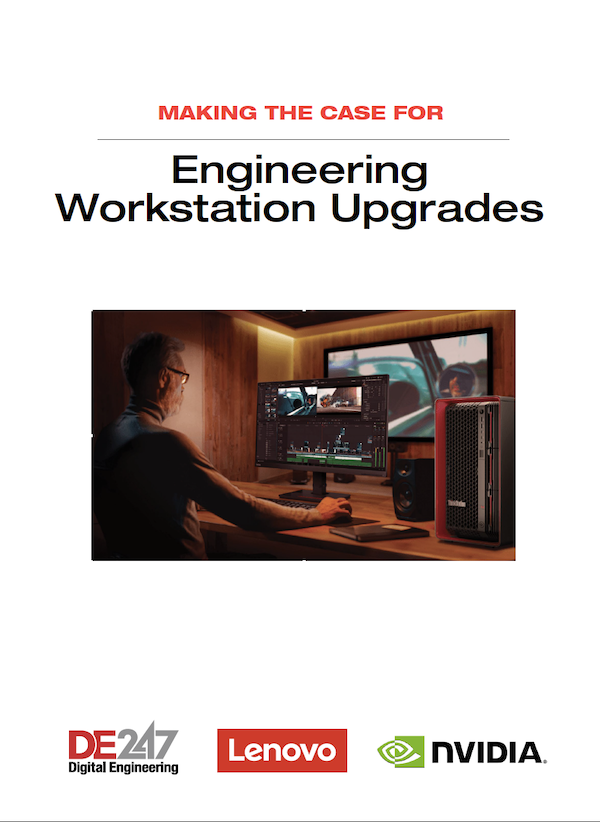Dell Precision 5550: Thin, Fast and Pricey
DE tests the world’s smallest 15-in. mobile workstation.
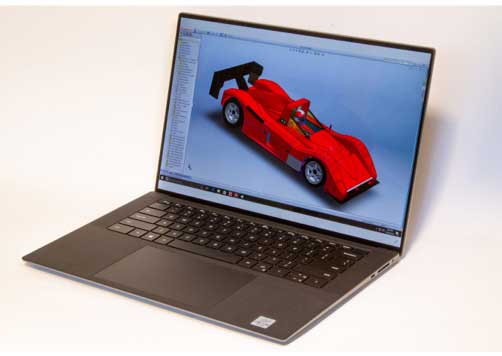
The Dell Precision 5550 packs power and a gorgeous display into a thin, lightweight chassis with minimal ports. Image/charts courtesy of David Cohn.
Latest News
September 15, 2020
Dell recently announced a couple of new mobile workstations in its Precision line—the 5550 and 5570—offering the portability of a laptop and the processing power of a desktop PC. The Precision 5550 is reportedly the world’s smallest 15-in. mobile workstation, according to Dell. A few weeks later, we received one of these new systems and immediately put it to the test.
As soon as it arrived, the new Dell Precision 5550 grabbed our attention. Nestled inside an elegant hinged black box made with 100% recycled materials, unpacking the Precision 5550 was a treat. And the computer packed inside that box was indeed incredibly thin.
Like the Precision 7540 we recently reviewed (see DE, April 2020), the Dell Precision 5550 comes housed in a silver-colored case. But while the 7540 was more than an inch thick, the Dell Precision 5550 is less than half that. Its case measures a mere 13.56×9.07×0.46-in. (WxDxH) and our evaluation unit weighed just 4.42 lbs., plus 0.94 lb. for its 130-watt power supply (5.62×2.56×0.88-in.).
Great Design, Few Ports
Lifting the lid reveals a 15.6-in. display with a 16:10 aspect ratio and one of the thinnest bezels we have seen. Dell calls this new design “Infinity Edge.” Measuring just over 1/8-in. surrounding a panel surfaced with Corning Gorilla Glass, the result is a near borderless screen.
Dell still managed to place an RGB-infrared (red, green and blue-infrared) webcam centered in the top edge of the bezel, flanked by a pair of infrared emitters, an ambient-light sensor and a camera-status light, while a pair of microphones are located on the top edge of the case. The bezel is too thin to accommodate a privacy shutter.
The Dell Precision 5550 incorporates a 79-key backlit keyboard with a very good feel and ample 1.3-mm key travel. An additional key in the upper-right corner of the keyboard doubles as the power button and a fingerprint reader. The keyboard is flanked by a pair of top-firing stereo speakers that provide very good sound.
There are also a pair of slots along the bottom edge on either side of the case for left and right woofers. A large (5.94×3.56-in.) gesture-enabled touchpad, centered in the palm rest below the keyboard, lacks any dedicated buttons, but recognizes the difference between left- and right-clicks. Only the Caps Lock key includes an indicator light, while a battery status light is located on the front edge of the case, centered below the touchpad.
Though the reduced size of the Dell Precision 5550 is to be applauded (the system is 6% smaller than the previous generation), the thin chassis leaves limited space for external ports. The left side provides a wedge-shaped security lock slot and a pair of USB 3.2 Gen 2 Type-C ports with Thunderbolt 3. The right side hosts an additional USB 3.2 Gen 2 Type-C port, an SD-card slot and a 3.5-mm audio port. One of the Type-C ports on the left side is meant to be used to connect the external power supply, but you can plug the power supply into any of the Type-C ports.
There are no other ports—no USB Type-A ports at all—and the only air vents are located on the bottom of the case.
Our evaluation unit came with a small adapter that, when plugged into a USB Type-C port, provided a single HDMI port and a single USB Type-A port; this is simply not sufficient.
A minimum of two USB Type-A ports are often required (one for a mouse and the other for an external drive). Some users might also want an RJ-45 jack to connect to a gigabit network. Dell does sell several other adapters—including a USB-C mobile adapter ($70) that provides six ports (USB-A, USB-C, HDMI, VGA, DisplayPort and RJ-45) and a Thunderbolt Dock ($275) that houses 11 ports (three USB-A, two USB-C, HDMI, two DisplayPorts, two audio combo jacks and a power connector) plus both wedge-shaped and Kensington lock slots. There are also a number of third-party adapters that would work. Either way, you may want to include one of these as part of your purchase.
Ample Options
Although external connections are limited, Dell does offer quite a few internal options. With a starting price of $1,999, the base configuration includes an Intel Core i5-10400H 2.60GHz four core CPU with integrated Intel HD Graphics 630, a 1920×1200 display, 8GB of RAM, a 256GB M.2 PCIe NVMe Class 35 SSD, a 3-cell 56Whr lithium ion battery and a 90-watt power supply. But that is just the starting point.
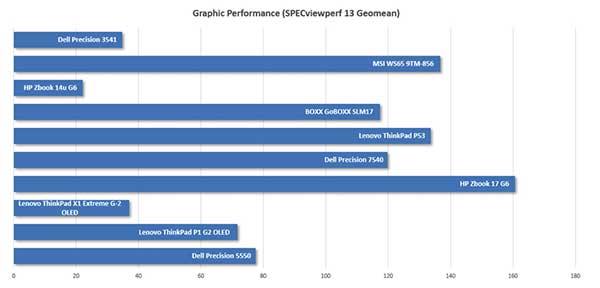
Dell presents a choice of five different 10th-generation 14nm processors. In response to competition from AMD Ryzen processors, these Comet Lake CPUs offer increased core counts and faster clock speeds.
In addition to the base four-core i5 CPU, you can opt for one of two Intel Core i7 6-core variants (the 2.6GHz i7-10750H or 2.7GHz i7-10850H), the eight-core i7-10875H, or the Xeon W 10855M (a 6-core CPU running at 2.8GHz).
All offer higher turbo-boost speeds than the previous generation, but the highest numbers are only achievable “opportunistically,” with what Intel calls “Thermal Velocity Boost.” This means the additional speed is only available periodically when the processor is operating below its maximum temperature.
Our evaluation unit came with an Intel Core i7-10875H CPU, an eight-core processor with a 2.30GHz base frequency, 5.10GHz max turbo, 16MB of Smart Cache and a thermal design power rating of 45 watts. This CPU added $382 to the base price.
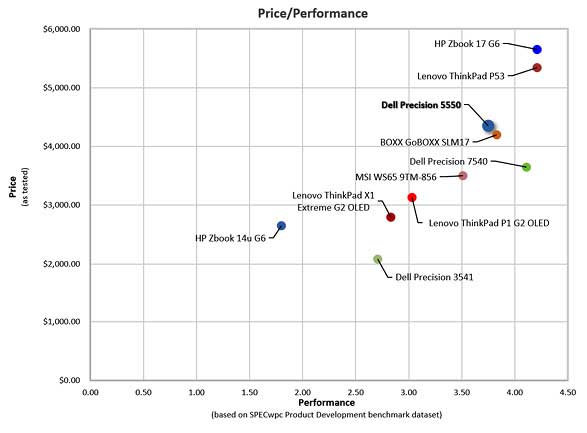
In addition to the integrated Intel graphics, Dell offers the Precision 5550 with a choice of two NVIDIA discrete graphics processing units (GPUs)—the Quadro T1000 ($140) or the Quadro T2000 ($266), which was included in the system we received. This GPU includes 4GB of GDDR5 memory and 1024 compute unified device architecture cores, while consuming 60 watts. Its 128-bit interface enables it to deliver a bandwidth of 128GB/second.
You also get a choice of two different displays. Our evaluation unit included a gorgeous 3840×2400 touch-enabled display covering 100% of the Adobe color gamut, adding $313 to the total cost.
Although the new 10th-generation Intel CPUs can support up to 128GB of memory, its two memory sockets mean that the Dell Precision 5550 is capped at a maximum of 64GB. Our system came with 32GB of RAM, installed as two 16GB DDR4 2933MHz modules, adding $420. Dell also offers error-correcting code memory for those systems equipped with a Xeon CPU.
The Dell Precision 5550 also supports up to two M.2 solid-state drives (with optional RAID 0 and RAID 1 on systems equipped with two identical drives). Capacities range from 256GB to 2TB. The system we received came with a 1TB PCIe NVMe Class 50 SSD, which added $734.
While a three-cell 56Whr battery comes standard, our system included a six-cell 86Whr lithium ion battery with ExpressCharge, which enables the battery to reach 80% in 60 minutes. That battery kept our Dell Precision 5550 running for an impressive 10 hours and 22 minutes. The computer was nearly silent during even the most demanding tests, but the underside got up to 115°F at times.
Great Performance
We had a very short time in which to evaluate this Dell mobile workstation, so we started running our suite of benchmarks as soon as the system arrived. On the SPECviewperf test, which measures pure graphics performance, the Precision 5550 did quite well, easily beating the scores of similarly equipped thin, lightweight mobile systems we recently tested; SPECapc SolidWorks benchmark scores were equally impressive.
On the very demanding SPEC workstation performance benchmarks, the Dell Precision 5500 also delivered very good results. It turned in the top score for general operations and its other results rank the 5550 among the recently tested systems. The Dell Precision 5550 also completed our multi-threaded AutoCAD rendering test in less than 39 seconds, placing it among the fastest mobile workstations we have ever tested.
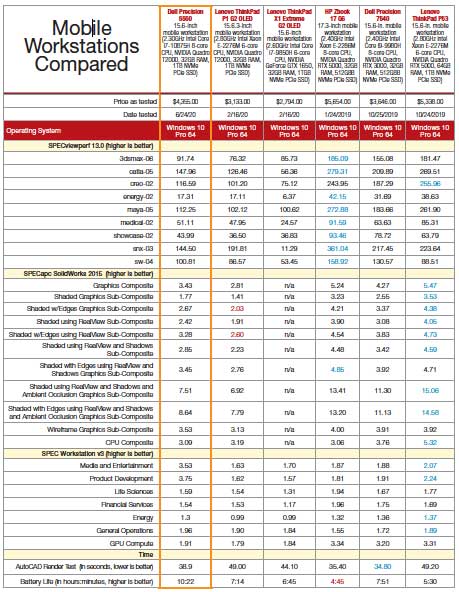
All Dell Precision 5550 systems are independent software vendor (ISV) certified for major CAD, DCC and scientific applications and include a copy of the Dell Precision Optimizer, which automatically tunes the system to run ISV applications. Windows 10 Pro 64-bit came pre-loaded. Systems based on a Xeon CPU require Windows 10 Pro for Workstations, which adds $154 to the price. Windows 10 Home and Ubuntu Linux are also available.
Like several other vendors, Dell’s standard warranty has been reduced to just one year of basic, onsite service. Warranties of up to five years are also available as are ProSupport with next business day onsite service, accidental damage coverage and an extended battery warranty. Since we base our as-reviewed price on systems with a three-year warranty, our cost includes the extra $173 for the longer warranty.
As configured, the Dell Precision 5550 priced out at $4,355, making it one of the more expensive mobile workstations we have tested recently. There are certainly faster, less expensive laptops out there, but none are as thin or lightweight as the Precision 5550. Just remember that you are paying a premium for that portability—and may need to spend a bit more for additional connectivity.
More Dell Coverage

Subscribe to our FREE magazine, FREE email newsletters or both!
Latest News
About the Author
David Cohn is a consultant and technical writer based in Bellingham, WA, and has been benchmarking PCs since 1984. He is a Contributing Editor to Digital Engineering, the former senior content manager at 4D Technologies, and the author of more than a dozen books. Email at [email protected] or visit his website at www.dscohn.com.
Follow DE





